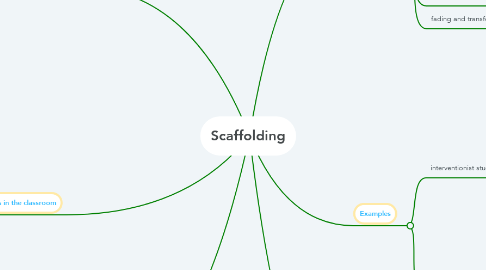
1. Classrom situation
1.1. rich social context
1.1.1. interaction
1.1.2. negotiation
1.1.3. articulation
1.1.4. collaboration
1.2. one-on-one interaction
1.2.1. titrated support
1.2.2. fine-tuned, sensitive, personalized exchange
1.3. project- or design-based activities
1.3.1. paper support
1.3.2. software tool
2. Software tools in the classroom
2.1. difficulties
2.1.1. inquiry
2.1.2. process management
2.1.3. sense making
2.1.4. data recording and analysis
2.1.5. articulation
2.2. mechanisms
2.2.1. structuring
2.2.1.1. decomposing
2.2.2. problematizing
2.2.2.1. focusing on aspects of the task
3. Peer interraction
3.1. supporting and critiquing
3.2. offering suggestions and explanations
3.3. justifying views and opinions
4. Key Features
4.1. the role of the adult or the expert
4.1.1. facilitating
4.1.2. motivating
4.1.3. supporting
4.1.3.1. modeling
4.1.3.2. highlighting
4.1.3.3. providing hints
4.2. common goal
4.3. ongoing diagnosis and adaptive support
4.4. dialogues and interactions
4.5. fading and transfer of responsibility
5. Examples
5.1. interventionist study
5.1.1. recruiting the child's interest
5.1.2. reducing the degrees of freedom by simplifying the task
5.1.3. maintaining direction
5.1.4. highlighting the critical task features
5.1.5. controlling frustration
5.1.6. demonstrating ideal solution paths
5.2. reciprocal teaching
5.2.1. modeling the strategies
5.2.2. prompting
5.2.3. instructing
5.2.4. modifying the activity
6. Distributed scaffolding
6.1. multiple forms of support
6.1.1. synergistic scaffolds
6.1.1.1. software+teacher-student interraction

